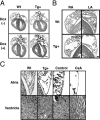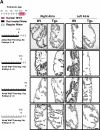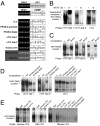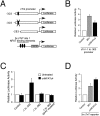Requirement of transcription factor NFAT in developing atrial myocardium
- PMID: 12796475
- PMCID: PMC2172977
- DOI: 10.1083/jcb.200301058
Requirement of transcription factor NFAT in developing atrial myocardium
Abstract
Nuclear factor of activated T cell (NFAT) is a ubiquitous regulator involved in multiple biological processes. Here, we demonstrate that NFAT is temporally required in the developing atrial myocardium between embryonic day 14 and P0 (birth). Inhibition of NFAT activity by conditional expression of dominant-negative NFAT causes thinning of the atrial myocardium. The thin myocardium exhibits severe sarcomere disorganization and reduced expression of cardiac troponin-I (cTnI) and cardiac troponin-T (cTnT). Promoter analysis indicates that NFAT binds to and regulates transcription of the cTnI and the cTnT genes. Thus, regulation of cytoskeletal protein gene expression by NFAT may be important for the structural architecture of the developing atrial myocardium.
Figures












Similar articles
-
Activation of the calcineurin-nuclear factor of activated T-cell signal transduction pathway in atrial fibrillation.Chest. 2004 Dec;126(6):1926-32. doi: 10.1378/chest.126.6.1926. Chest. 2004. PMID: 15596694
-
Characterization of Nfatc1 regulation identifies an enhancer required for gene expression that is specific to pro-valve endocardial cells in the developing heart.Development. 2005 Mar;132(5):1137-46. doi: 10.1242/dev.01640. Epub 2005 Feb 2. Development. 2005. PMID: 15689382
-
Direct and indirect interactions between calcineurin-NFAT and MEK1-extracellular signal-regulated kinase 1/2 signaling pathways regulate cardiac gene expression and cellular growth.Mol Cell Biol. 2005 Feb;25(3):865-78. doi: 10.1128/MCB.25.3.865-878.2005. Mol Cell Biol. 2005. PMID: 15657416 Free PMC article.
-
Sculpting heart valves with NFATc and VEGF.Cell. 2004 Sep 3;118(5):532-4. doi: 10.1016/j.cell.2004.08.022. Cell. 2004. PMID: 15339657 Review.
-
NFAT: ubiquitous regulator of cell differentiation and adaptation.J Cell Biol. 2002 Mar 4;156(5):771-4. doi: 10.1083/jcb.200111073. Epub 2002 Mar 4. J Cell Biol. 2002. PMID: 11877454 Free PMC article. Review.
Cited by
-
The mitochondrial respiratory chain controls intracellular calcium signaling and NFAT activity essential for heart formation in Xenopus laevis.Mol Cell Biol. 2007 Sep;27(18):6420-32. doi: 10.1128/MCB.01946-06. Epub 2007 Jul 16. Mol Cell Biol. 2007. PMID: 17636012 Free PMC article.
-
Epigenomic and Proteomic Changes in Fetal Spleens Persistently Infected with Bovine Viral Diarrhea Virus: Repercussions for the Developing Immune System, Bone, Brain, and Heart.Viruses. 2022 Feb 28;14(3):506. doi: 10.3390/v14030506. Viruses. 2022. PMID: 35336913 Free PMC article.
-
Hematopoietic Stem Cell Transcription Factors in Cardiovascular Pathology.Front Genet. 2020 Oct 16;11:588602. doi: 10.3389/fgene.2020.588602. eCollection 2020. Front Genet. 2020. PMID: 33193725 Free PMC article. Review.
-
The role of nuclear factor of activated T cells during phorbol myristate acetate-induced cardiac differentiation of mesenchymal stem cells.Stem Cell Res Ther. 2016 Jul 12;7(1):90. doi: 10.1186/s13287-016-0348-6. Stem Cell Res Ther. 2016. PMID: 27405982 Free PMC article.
-
Genetic inhibition of nuclear factor of activated T-cell c2 prevents atrial fibrillation in CREM transgenic mice.Cardiovasc Res. 2022 Oct 21;118(13):2805-2818. doi: 10.1093/cvr/cvab325. Cardiovasc Res. 2022. PMID: 34648001 Free PMC article.
References
-
- Agarwal, S., O. Avni, and A. Rao. 2000. Cell-type-restricted binding of the transcription factor NFAT to a distal IL-4 enhancer in vivo. Immunity. 12:643–652. - PubMed
-
- Aramburu, J., F. Garcia-Cozar, A. Raghavan, H. Okamura, A. Rao, and P.G. Hogan. 1998. Selective inhibition of NFAT activation by a peptide spanning the calcineurin targeting site of NFAT. Mol. Cell. 1:627–637. - PubMed
-
- Ausoni, S., M. Campione, A. Picard, P. Moretti, M. Vitadello, C. De Nardi, and S. Schiaffino. 1994. Structure and regulation of the mouse cardiac troponin I gene. J. Biol. Chem. 269:339–346. - PubMed
-
- Barton, P.J., M.E. Cullen, P.J. Townsend, N.J. Brand, M.J. Mullen, D.A. Norman, P.K. Bhavsar, and M.H. Yacoub. 1999. Close physical linkage of human troponin genes: organization, sequence and expression of the locus encoding cardiac troponin I and slow skeletal troponin T. Genomics. 57:102–109. - PubMed
Publication types
MeSH terms
Substances
Grants and funding
LinkOut - more resources
Full Text Sources
Molecular Biology Databases
Research Materials

